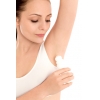|
 The Earth
is habited with over four billion of humans and every single one has their own
specific scent of physiology. The physiological odor is the scent of the human secretion
but not the odor from strong sweating. The scientists proved the fact that the
human sweat has nothing to do with the freshness of ambient air. The microbes matter
the biological activity of which brings to creation of strong odors to some
extent. To struggle with odors, whatever they are created by, the deodorants
have been produced to come as spray, stick deodoro and roll-on deodorants. The Earth
is habited with over four billion of humans and every single one has their own
specific scent of physiology. The physiological odor is the scent of the human secretion
but not the odor from strong sweating. The scientists proved the fact that the
human sweat has nothing to do with the freshness of ambient air. The microbes matter
the biological activity of which brings to creation of strong odors to some
extent. To struggle with odors, whatever they are created by, the deodorants
have been produced to come as spray, stick deodoro and roll-on deodorants.
Sweat-struggling
agent was first mentioned in Ancient Egypt. The scrip of beauty employed by the
beautiful legendary Cleopatra had the recipe against sweating. The sweating
person was recommended to take a bath and rub aroma oils into arm-pit areas. The
collection revealed the first recipe of anti-perspiring agent made from citric fruits
and cinnamon. The Egyptian papyrus was the first documents to mention the
procedure of epilation as the approach to make the odor weaker. As the legend tells,
the beauty Nefertiti,
the Great royal Wife, used the composition made from aroma essences
to prevent the physiological aroma along with the piece of red clay rubbed into
the mixture. Men and women in Ancient Rome used to carry bags filled in with
various aroma substances placed in armpits.
Later on the
struggle with sweating was postponed sine robbing of human odor was like a sin.
The idea came from the aggressive wars from the East when the perfume was
brought from there. In the soonest time all the European courts smelled with
the detonating mixture of sweat and perfume. And only in the end of the 19th
century the invention was opened that the odor was created because of the
bacteria vital activity in the armpits.
In 1888 deodorant
was invented, one of the genius inventions of the humankind. The name of the
American was not kept in history to remember that is still demanded in the 21st
century. The first deodorant was first manufactured as the cream which was
rubbed in fingers in areas of sweating to name Mum. To the early 20th
century that was the only method to remove the odor for a couple of hours. In 1931
the Mum Company penetrated Europe with the new
invention to stay dry forever, namely the perfumed deodorant.
In the end
of 40s of 20th century the manufacturers of the most popular product
came with the thought to improve the pack of their product which was quite
uncomfortable to apply since hands should have been washed off after. So, in
1952 the first roll-on deodorant was manufactured, that invention was resulted
in invention of the roll-on pen in 1938 by BíróLászló József. And that is the same mechanism
we use today. In 21st century the roll-on deodorants keep the
leading positions among the body fresheners of the world.
The advantages
of the roll-on packages is the immediate removal of odor; quick stop of
sweating; easy application, availability off additional features when
deodorants nourish, moisturize and rejuvenate the skin. The disadvantage of this
pack includes the ambiguity of the influence on human health since such
substances as paraben and aluminum salts are used as components. The point is
that according to the statistics the results of the research held with people
who actively use deodorants, the risk of malignant tumor occurrence is likely. The
specialist state that regular use of deodorants brings to clogging the pores of
the skin which then block the glandulae sudoriferae. And yet, the toxins, waste
and salts are extracted from the organism. The deodorants fall into the
categories that differ in regards to gender. Roll-on deodorants for men are
more concentrated with sharp scent packed in more aggressive packing.
The deodorants
for women are less concentrated with the subtle scent in feminine bottles. The deodorants
are also divided into those for people with sensitive skin, for active life,
for sportsmen. As for the components they come with spirit, alcohol-free, with
deodorants only, with agents to hide the odor and anti-perspiration agents that
reduce sweating process.
|